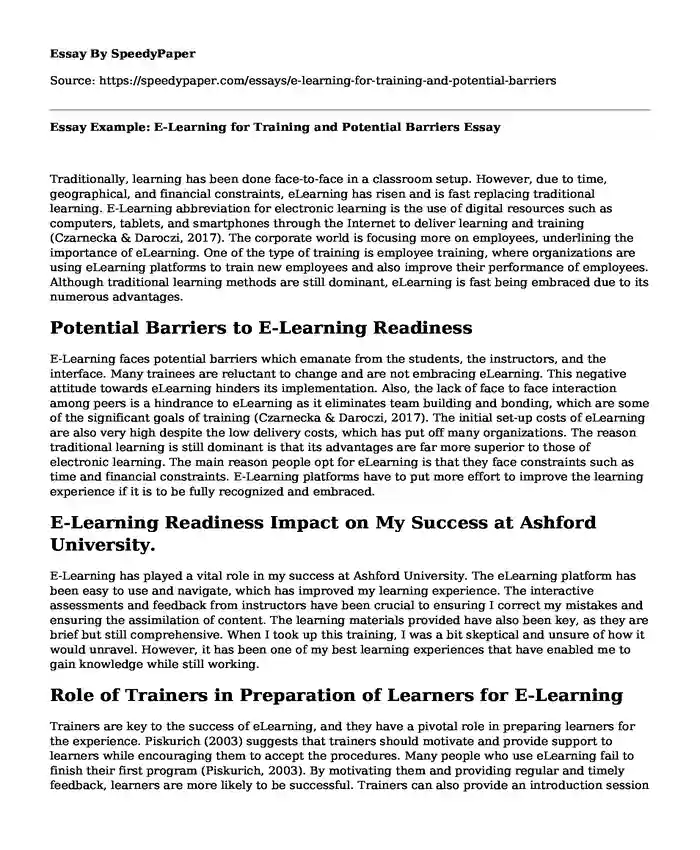
| Type of paper: | Essay |
| Categories: | Learning Knowledge Information technologies |
| Pages: | 3 |
| Wordcount: | 627 words |
Traditionally, learning has been done face-to-face in a classroom setup. However, due to time, geographical, and financial constraints, eLearning has risen and is fast replacing traditional learning. E-Learning abbreviation for electronic learning is the use of digital resources such as computers, tablets, and smartphones through the Internet to deliver learning and training (Czarnecka & Daroczi, 2017). The corporate world is focusing more on employees, underlining the importance of eLearning. One of the type of training is employee training, where organizations are using eLearning platforms to train new employees and also improve their performance of employees. Although traditional learning methods are still dominant, eLearning is fast being embraced due to its numerous advantages.
Potential Barriers to E-Learning Readiness
E-Learning faces potential barriers which emanate from the students, the instructors, and the interface. Many trainees are reluctant to change and are not embracing eLearning. This negative attitude towards eLearning hinders its implementation. Also, the lack of face to face interaction among peers is a hindrance to eLearning as it eliminates team building and bonding, which are some of the significant goals of training (Czarnecka & Daroczi, 2017). The initial set-up costs of eLearning are also very high despite the low delivery costs, which has put off many organizations. The reason traditional learning is still dominant is that its advantages are far more superior to those of electronic learning. The main reason people opt for eLearning is that they face constraints such as time and financial constraints. E-Learning platforms have to put more effort to improve the learning experience if it is to be fully recognized and embraced.
E-Learning Readiness Impact on My Success at Ashford University.
E-Learning has played a vital role in my success at Ashford University. The eLearning platform has been easy to use and navigate, which has improved my learning experience. The interactive assessments and feedback from instructors have been crucial to ensuring I correct my mistakes and ensuring the assimilation of content. The learning materials provided have also been key, as they are brief but still comprehensive. When I took up this training, I was a bit skeptical and unsure of how it would unravel. However, it has been one of my best learning experiences that have enabled me to gain knowledge while still working.
Role of Trainers in Preparation of Learners for E-Learning
Trainers are key to the success of eLearning, and they have a pivotal role in preparing learners for the experience. Piskurich (2003) suggests that trainers should motivate and provide support to learners while encouraging them to accept the procedures. Many people who use eLearning fail to finish their first program (Piskurich, 2003). By motivating them and providing regular and timely feedback, learners are more likely to be successful. Trainers can also provide an introduction session where the learners get to interact. The trainer should also provide guidelines on how to use the eLearning platforms and how the assessments will be done, which eliminate initial challenges faced by learners.
Conclusion
E-Learning is fast gaining recognition due to its advantages, such as providing convenience and flexibility to learners and organizations. However, it faces barriers in its use with many learners failing to complete programs due to lack of encouragement, which is partly due to the inadequacy of trainers and facilitators. Trainers, therefore, have a vital role to play in ensuring that learners do not face challenges in the learning experience and receive constant motivation and direction to keep them on track. My experience at Ashford has been a success with the trainers taking most of the credit as well as the easy-to-use platform.
References
Czarnecka, A, & Daroczi, M. (2017). E-learning as a method of employee development and training. Budapest, BP: Agroinform Publishing House.
Piskurich, G. M. (2003). Preparing Learners for e-Learning. San Francisco, CA: John Wiley and Sons.
Cite this page
Essay Example: E-Learning for Training and Potential Barriers. (2023, Feb 07). Retrieved from https://speedypaper.com/essays/e-learning-for-training-and-potential-barriers
Request Removal
If you are the original author of this essay and no longer wish to have it published on the SpeedyPaper website, please click below to request its removal:
- Essay Example on Averroe's Philosophy
- Essay Sample on Incarceration Rate and Black Lives Matter Movement
- Free Essay about Character Sketch
- Free Essay on Why Katherine Johnson Inspires and Motivates Me
- Free Essay: Using Bee Colony for Solving Traveling Salesman Problems TSP
- Essay Sample on How Internet Use Influence People's Lives, Work, and Study
- Physical, Psychological and Sexual Abuse - Free Essay Sample
Popular categories




